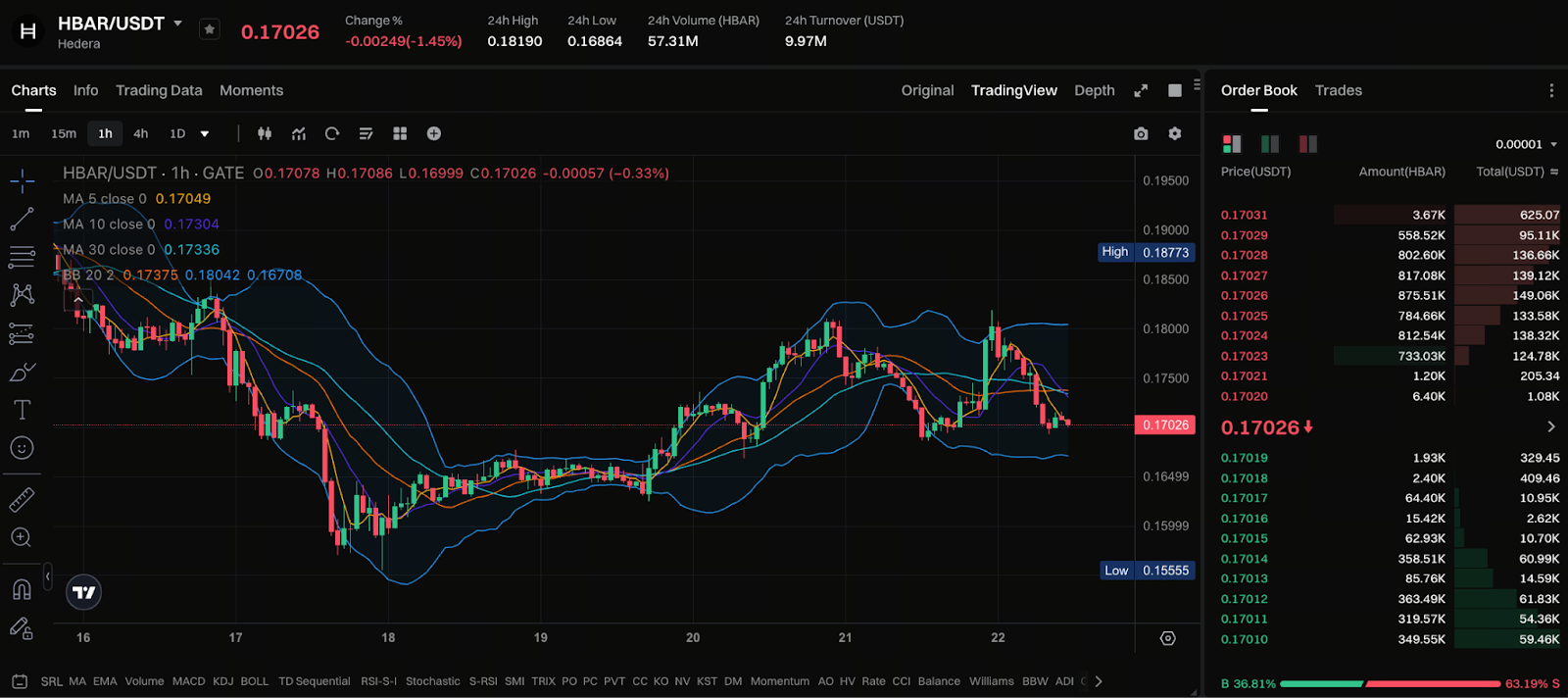HBAR Outlook Explained: Low-Price Opportunity or Future Breakout Potential?
What Is HBAR?
HBAR is the native cryptocurrency of Hedera Hashgraph, the blockchain and distributed ledger platform governed by the Hedera Governing Council. It powers transactions, smart contracts, and staking across the Hedera network. Distinct from traditional blockchains, Hedera leverages the Hashgraph consensus algorithm, which has high throughput, low transaction fees, and is suitable for enterprise-grade applications. For newcomers, understanding HBAR means exploring not just the token itself but also the broader platform ecosystem and its practical uses.
Recent Market Developments and Price Performance

Chart: https://www.gate.com/trade/HBAR_USDT
HBAR has experienced notable price volatility in recent trading sessions. The token currently trades in the $0.15–$0.18 range. Analysts point out that HBAR recently rebounded from around $0.16 and tested resistance at approximately $0.18. Additionally, reports indicate that institutional selling drove HBAR below a key support level to about $0.1688, before recovering to around $0.1745. These movements suggest the market remains in a tug of war over HBAR, with hope for short-term rebounds balanced by the risk of support breakdowns.
Key Catalysts for HBAR
Several factors stand out as potential drivers for HBAR’s future:
- ETF Approval Outlook: Multiple HBAR ETF applications are reportedly progressing in the U.S., with a 60%–80% chance of approval anticipated in Q4 2025. Approval could attract substantial institutional investment.
- Enterprise Partnerships and Ecosystem Growth: Hedera continues to secure partnerships with major corporations and government entities, spanning areas like SWIFT, IoT, and tokenization projects.
- Technical Analysis and Price Patterns: Bullish RSI divergence and support holding near $0.16 could set the stage for a short-term upward move.
If these catalysts align, HBAR could be poised for a breakout opportunity.
Investment Opportunity Analysis
For those new to crypto, HBAR presents several attractive entry points:
- Low Entry Cost, High Growth Potential: Entering at the current $0.15–$0.18 price range offers a lower barrier compared to most major coins.
- Strong News-Driven Upside: Positive developments such as ETF approvals or successful enterprise integrations could significantly boost market sentiment.
Technical Upside Potential: Maintaining key support and breaking through $0.19 may deliver notable returns.
As a result, HBAR is a candidate worth monitoring for investors seeking medium- to long-term growth opportunities in digital assets.
Risks Newcomers Should Watch
Every investment opportunity carries risk, and HBAR is no exception:
- Support Breakdown Risk: A fall below the $0.16 support could push prices down to $0.12 or lower.
- Market Sentiment Swings: The crypto sector is highly sensitive to macroeconomic factors, regulatory shifts, and liquidity changes—HBAR’s potential doesn’t shield it from these swings.
- Uncertain Outcomes: ETF approvals and enterprise adoption are not guaranteed; failed expectations could put downward pressure on price.
- Entry Timing and Risk Management: New investors should avoid going “all in,” consider phased and small-scale entries, and implement strict stop-loss and risk controls.
Conclusion
In summary, HBAR offers a blend of “low price and high potential” that makes it a compelling option for novice investors. Key catalysts—including ETF prospects, ecosystem partnerships, and technical rebound signals—could deliver solid upside if realized. However, risks such as support breakdowns, adverse market conditions, and unmet expectations remain. New entrants should consider a strategy of “observe → small-scale trial → phased accumulation,” and prioritize disciplined stop-loss and risk management practices.
Related Articles

2025 BTC Price Prediction: BTC Trend Forecast Based on Technical and Macroeconomic Data

Flare Crypto Explained: What Is Flare Network and Why It Matters in 2025

Pi Coin Transaction Guide: How to Transfer to Gate.com

How to Use a Crypto Whale Tracker: Top Tool Recommendation for 2025 to Follow Whale Moves

What is N2: An AI-Driven Layer 2 Solution
